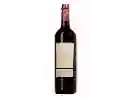
Domaine de MontelsLes Vignes d'Aline
This wine is a blend of 2 varietals which are the Cabernet franc and the Merlot.
This wine generally goes well with pork, poultry or beef.
Food and wine pairings with Les Vignes d'Aline
Pairings that work perfectly with Les Vignes d'Aline
Original food and wine pairings with Les Vignes d'Aline
The Les Vignes d'Aline of Domaine de Montels matches generally quite well with dishes of beef, lamb or pork such as recipes of scottish haggis, grilled lamb shoulder with spices and honey or pork chops with curry and honey.
Details and technical informations about Domaine de Montels's Les Vignes d'Aline.
Discover the grape variety: Cabernet franc
Cabernet Franc is one of the oldest red grape varieties in Bordeaux. The Libourne region is its terroir where it develops best. The terroirs of Saint-Emilion and Fronsac allow it to mature and develop its best range of aromas. It is also the majority in many blends. The very famous Château Cheval Blanc, for example, uses 60% Cabernet Franc. The wines produced with Cabernet Franc are medium in colour with fine tannins and subtle aromas of small red fruits and spices. When blended with Merlot and Cabernet Sauvignon, it brings complexity and a bouquet of aromas to the wine. It produces fruity wines that can be drunk quite quickly, but whose great vintages can be kept for a long time. It is an earlier grape variety than Cabernet Sauvignon, which means that it is planted as far north as the Loire Valley. In Anjou, it is also used to make sweet rosé wines. Cabernet Franc is now used in some twenty countries in Europe and throughout the world.
Informations about the Domaine de Montels
The Domaine de Montels is one of of the world's greatest estates. It offers 20 wines for sale in the of South West to come and discover on site or to buy online.
The wine region of South West
The South-West is a large territorial area of France, comprising the administrative regions of Aquitaine, Limousin and Midi-Pyrénées. However, as far as the French wine area is concerned, the South-West region is a little less clear-cut, as it excludes Bordeaux - a wine region so productive that it is de facto an area in its own right. The wines of the South West have a Long and eventful history. The local rivers play a key role, as they were the main trade routes to bring wines from traditional regions such as Cahors, Bergerac, Buzet and Gaillac to their markets.
The word of the wine: Net
Said of a frank wine with well-defined characteristics.














